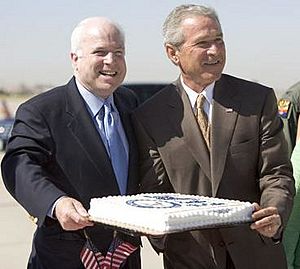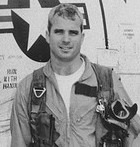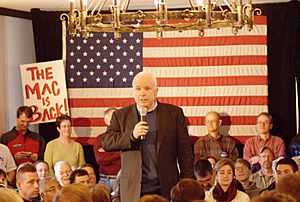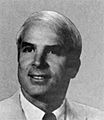John McCain facts for kids
Quick facts for kids
John McCain
|
|
|---|---|
 |
|
| United States Senator from Arizona |
|
| In office January 3, 1987 – August 25, 2018 Serving with Jeff Flake
|
|
| Preceded by | Barry Goldwater |
| Member of the U.S. House of Representatives from Arizona's 1st district |
|
| In office January 3, 1983 – January 3, 1987 |
|
| Preceded by | John Jacob Rhodes |
| Succeeded by | John Jacob Rhodes III |
| Personal details | |
| Born |
John Sidney McCain III
August 29, 1936 Coco Solo Naval Air Station, Panama Canal Zone |
| Died | August 25, 2018 (aged 81) Phoenix, Arizona, U.S. |
| Nationality | American |
| Political party | Republican |
| Spouses |
Carol Shepp
(m. 1965–1980) |
| Relations | John S. McCain, Sr. (grandfather) John S. McCain, Jr. (father) Roberta McCain (mother) |
| Children | 7 |
| Alma mater | United States Naval Academy |
| Profession | Pilot, Politician |
| Signature |  |
| Military service | |
| Allegiance | |
| Branch/service | |
| Years of service | 1958–1981 |
| Battles/wars | Vietnam War (POW) |
| Awards |
|
John Sidney McCain III (August 29, 1936 – August 25, 2018) was an American politician. He served as a United States Senator for Arizona. He was first elected to this role in 1986.
McCain was the Republican candidate for President of the United States in the 2008 election. He ran against Barack Obama and lost.
He graduated from the United States Naval Academy in 1958. He followed his father and grandfather into the U.S. Navy. Both his father and grandfather were admirals. McCain became a naval aviator and flew planes from aircraft carriers.
During the Vietnam War, he was nearly killed in a ship fire in 1967. Later that year, he was shot down during a bombing mission over Hanoi. He was seriously injured and captured by the North Vietnamese. McCain was a prisoner of war until 1973. He faced difficult conditions and injuries that affected him for life.
He retired from the Navy as a captain in 1981. After leaving the military, he moved to Arizona and began his political career.
In 1982, McCain was elected to the United States House of Representatives. He served two terms there. He then became a U.S. Senator in 1987. He was re-elected five times, with his last win in 2016.
McCain ran for the Republican presidential nomination in 2000. He lost to Governor George W. Bush. He won the nomination in 2008, but was defeated by Barack Obama.
Later, he often disagreed with the Obama administration, especially on foreign policy. By 2013, he became a very important person in the Senate. In 2015, McCain became the Chairman of the Senate Armed Services Committee.
Contents
Early Life and Education
John McCain was born on August 29, 1936. His birthplace was the Coco Solo Naval Air Station in the Panama Canal Zone. His father, John S. McCain, Jr., was a naval officer. His mother was Roberta McCain. He had an older sister, Sandy, and a younger brother, Joe. At that time, the Panama Canal was controlled by the U.S.
McCain's family had ancestors from Scotland, Ireland, and England. Both his father and his grandfather, John S. McCain, Sr., became four-star United States Navy admirals. Because of his father's naval career, the McCain family moved often. They lived in different places in the United States and the Pacific.
He attended about 20 different schools. In 1951, his family settled in Northern Virginia. McCain went to Episcopal High School, a private boarding school in Alexandria. He was good at wrestling and finished school in 1954.
Following his family's tradition, McCain entered the United States Naval Academy at Annapolis. He also became a lightweight boxer. McCain did well in subjects he liked, such as literature and history. However, he only studied enough to pass difficult subjects like math. He sometimes had problems with higher-ranking officers and didn't always follow the rules. This led to a low class rank when he graduated in 1958.
Prisoner of War Experience
McCain was captured on October 26, 1967. He was on his 23rd bombing mission over North Vietnam. His A-4E Skyhawk plane was shot down by a missile over Hanoi. When he ejected from the plane, he broke both arms and a leg. He almost drowned after parachuting into Trúc Bạch Lake.
Some North Vietnamese people pulled him out of the water. Others then hit his shoulder with a rifle and stabbed him with a bayonet. McCain was taken to Hanoi's main Hỏa Lò Prison. American prisoners called this prison the "Hanoi Hilton."
Even though McCain was badly hurt, his captors did not treat his injuries. They beat and questioned him to get information. He only received medical care when the North Vietnamese found out his father was a high-ranking admiral. His status as a prisoner of war (POW) was reported in major newspapers.
McCain spent six weeks in the hospital, where he received very poor care. He lost 50 pounds and was in a chest cast. His hair turned white. In December 1967, McCain was put in a cell with two other Americans. They thought he would not live more than a week. In March 1968, McCain was put in solitary confinement, where he stayed for two years.
In 1968, his father, John S. McCain, Jr., became the commander of all U.S. forces in Vietnam. The North Vietnamese offered McCain an early release. They wanted to use this for propaganda and to show other POWs that some prisoners were treated better. McCain refused to be released unless every man captured before him was also set free. This was because of the POWs' Code of Conduct. It said that officers should be released in the order they were captured to prevent the enemy from using them for propaganda.
Starting in August 1968, McCain was severely tortured. Eventually, McCain made an anti-U.S. propaganda "confession." He always felt that this statement was dishonorable. He later wrote, "I had learned what we all learned over there: every man has his breaking point. I had reached mine." Many U.S. POWs were tortured to get "confessions" or propaganda statements. Almost all of them eventually gave in to their captors. McCain was beaten two or three times a week because he kept refusing to sign more statements.
McCain was a prisoner of war in North Vietnam for five and a half years. He was released on March 14, 1973. His war injuries meant he could never raise his arms above his head again. Since his release, McCain returned to the prison site a few times with his wife Cindy and family. This helped him come to terms with what happened to him there.
After his release, McCain received treatment for his injuries. This included months of difficult physical therapy. He attended the National War College in Washington, D.C., from 1973 to 1974. By late 1974, McCain was better, and he was allowed to fly planes again. In 1976, he became the commanding officer of a training squadron in Florida.
From 1977, McCain served as the Navy's contact person for the U.S. Senate.
McCain retired from the Navy on April 1, 1981, as a captain. He was given a disability pension because of his injuries. After leaving the military, he moved to Arizona. He received many military awards, including the Silver Star Medal, two Legions of Merit, the Distinguished Flying Cross, three Bronze Star Medals, two Purple Heart Medals, two Navy and Marine Corps Commendation Medals, and the Prisoner of War Medal.
Health and Later Senate Work
In July 2017, John McCain was diagnosed with brain cancer. After this diagnosis, he took on a smaller role in the Senate. He cast his last vote in December of that year. President Trump and former President Obama both publicly wished Senator McCain well.
McCain was reported to be in good spirits while recovering at home in Arizona. He was thankful to the doctors at Mayo Clinic for their excellent care. On July 24, McCain announced on Twitter that he would return to the Senate the next day.
On July 25, 2017, less than two weeks after brain surgery, McCain returned to the Senate. He cast a very important vote that allowed the Senate to start discussing bills to replace Obamacare. In his speech, he criticized the party-line voting process. He urged a "return to regular order," meaning using the usual committee hearings and discussions. On July 28, he cast the deciding vote against the Republicans' final proposal that month, which failed.
McCain did not vote in the Senate after December 2017. He stayed in Arizona to receive cancer treatment. On April 15, 2018, he had surgery for an infection related to diverticulitis. The next day, he was reported to be in stable condition.
Death
On August 24, 2018, McCain's family announced that he was stopping treatment for his brain cancer. John McCain died the next day, on August 25, 2018.
Images for kids
-
McCain at the Naval Academy, 1954
-
McCain in 1983, during his first term in the House of Representatives
-
President Ronald Reagan greets McCain as First Lady Nancy Reagan looks on, March 1987
-
President George H. W. Bush meets with McCain, 1990
-
McCain's grandfather and father on board a U.S. ship in Tokyo Bay, circa end of World War II in 1945
-
McCain's Senate website from 2003 to 2006 illustrated his concern about pork barrel spending.
-
U.S. President George W. Bush with Senator McCain, December 4, 2004
-
General David Petraeus and McCain in Baghdad, November 2007
-
McCain formally announces his candidacy for president in Portsmouth, New Hampshire, 2007
-
President Bush holds Cindy McCain's hand as he endorses her husband for president, March 5, 2008
-
The Palins and McCains campaign in Fairfax, Virginia, following the 2008 Republican National Convention on September 10
-
U.S. President Barack Obama and McCain at a press conference in March 2009
-
The "Three Amigos" walking in Kunar Province in eastern Afghanistan in July 2011: McCain (second from left), Lindsey Graham (second from right in front), Joe Lieberman (right in front)
-
Kerry (far left) and McCain (third from left) with members of the Saudi Royal Family after greeting the new King Salman of Saudi Arabia, Riyadh, January 2015
-
Taiwanese President Tsai Ing-wen meets with McCain, who is the leader of the U.S. Senate delegation, June 2016
-
McCain campaigning with former Governor Romney in Mesa, Arizona, during his 2016 re-election campaign
-
The National March on the NRA in August 2018. The NRA spent $7.74 million to support John McCain.
-
U.S. Secretary of Defense Ash Carter and Senators Joni Ernst, Daniel Sullivan, John McCain, Tom Cotton, Lindsey Graham, and Cory Gardner attending the 2016 International Institute for Strategic Studies Asia Security Summit in Singapore
-
Grave of John McCain III next to his Naval Academy classmate Charles R. Larson at the United States Naval Academy Cemetery
-
Cindy McCain, Secretary James Mattis and Chief of Staff John F. Kelly lay a wreath at the Vietnam Veterans Memorial.
See Also
 In Spanish: John McCain para niños
In Spanish: John McCain para niños


































